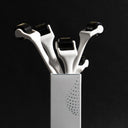Choosing between finasteride spray and pills for hair loss can be challenging. Both have unique benefits and considerations.
In this article, we'll explore the key differences to help you decide which option is best for your hair loss treatment.
Table of content
What is finasteride?

Finasteride is a prescription medication primarily used to treat male pattern baldness and benign prostatic hyperplasia (BPH). It works by inhibiting the enzyme 5-alpha reductase, which converts testosterone into dihydrotestosterone (DHT), a hormone that can contribute to hair loss and prostate growth.
Further, finasteride's mechanism of action makes it a valuable tool in managing conditions sensitive to DHT.
In the case of hair loss, DHT can shrink hair follicles, leading to thinner, shorter hairs and, eventually, hair loss.
Finasteride can slow down or even reverse this process in some individuals by inhibiting the conversion of testosterone to DHT.
While it's typically prescribed for men due to its potential side effects in women, it has been used off-label in post-menopausal women or those not planning to conceive.
However, women of childbearing age should not use finasteride due to the risk of birth defects.
As your leading source for hair health information over the past 4 years, we never compromise on accuracy. When it comes to your health, you deserve information you can truly rely on - and earning your trust is our top priority.
Here's how Scandinavian Biolabs ensures every piece of content meets the highest standards of accuracy and integrity:
- Credentialed Experts: Our reviewers are actively practicing doctors and medical researchers
- Stringent Reviews: Content undergoes rigorous editing by subject specialists and review by a practicing doctor.
- Evidence-Based: We rely on well-established research from trusted scientific sources like peer-reviewed journals and health authorities.
- Full Transparency: Our editorial standards, writer credentials, reviewer credentials, correction process, and funding are all publicly documented.
- Independent Voice: While we do promote products, we operate in a vacuum to business operations. Our main goal is just an unwavering commitment to providing medically-sound guidance.
You can count on Scandinavian Biolabs to consistently deliver the trustworthy health information you deserve. Read our Editorial Standards.
How does finasteride work?
Finasteride works by inhibiting the enzyme 5-alpha reductase, which is responsible for converting testosterone into its more potent form, dihydrotestosterone (DHT). By reducing DHT levels, finasteride can help slow down or even reverse the process of hair miniaturisation and hair loss caused by androgenetic alopecia.
What is topical finasteride?

Topical finasteride is a medication applied directly to the scalp to help treat hair loss, specifically male pattern baldness or androgenetic alopecia. It works by inhibiting the enzyme 5-alpha reductase, which converts testosterone into dihydrotestosterone (DHT), a hormone that contributes to hair loss.
Compared to its oral counterpart, topical finasteride has emerged as a novel intervention in the fight against hair loss.
The topical form is designed to target the scalp directly, offering a localised hair loss treatment intended to reduce systemic exposure and potential side effects.
It's typically available as a liquid or a gel and applied directly to the scalp, where it can directly interact with hair follicles.
The main advantage of topical finasteride over the oral version is its reduced systemic absorption, which could lead to fewer side effects.
However, research is ongoing to fully understand this form of treatment's efficacy and safety profile.
Some studies suggest topical finasteride can be as effective as oral finasteride in promoting hair growth and preventing further hair loss.
Individuals should consult with a healthcare professional before starting any new medication regimen.
How effective is topical finasteride?
Topical finasteride is effective in treating male pattern baldness or androgenetic alopecia. Its efficacy is highlighted by its potential to stimulate hair growth and prevent further loss. However, effectiveness can vary between individuals, influenced by factors such as consistent application and concentration of the medication.
What is oral finasteride?

Oral finasteride is a prescription medication used primarily to treat male pattern baldness, known as androgenetic alopecia. It works by reducing dihydrotestosterone (DHT) levels, a hormone that contributes to hair loss in men.
Oral finasteride, usually available in 1mg tablets, is often prescribed under Propecia for hair loss.
It operates on a systemic level, affecting the whole body. Inhibiting the conversion of testosterone to DHT can slow down, halt, or even reverse hair loss in some men.
However, while oral finasteride can be effective, it's important to note that it can also lead to side effects in some individuals, with potential issues ranging from sexual dysfunction to mood changes.
It's a long-term treatment, meaning its effects will only last as long as the medication is taken.
Therefore, it's crucial for anyone considering oral finasteride to consult with a healthcare professional to fully understand its potential benefits and risks.
How effective is oral finasteride?
Oral finasteride is highly effective in treating male pattern baldness, also known as androgenetic alopecia. Numerous studies have shown that it can significantly slow down, halt, or even reverse hair loss in some men.
However, its effectiveness can vary between individuals, and its hair regrowth benefits are usually only sustained as long as the medication is taken.
What are the side effects of finasteride?
Finasteride, whether oral or topical, can have potential side effects. It's important to note that while these side effects are possible, they may not occur in all individuals. Always consult with a healthcare professional before starting any new medication.
Sexual side effects:
- Decreased sex drive
- Difficulty getting or maintaining an erection
- Decreased semen volume
Physical side effects:
- Swelling in your hands or feet
- Swelling or tenderness in your breasts
- Dizziness, weakness
- Feeling like you might pass out
- Headaches
Psychological side effects:
- Depression
- Anxiety
- Mental fogginess
- Sleep disturbances
Allergic reactions:
- Hives
- Difficulty breathing
- Swelling of your face, lips, tongue, or throat
Long-term side effects:
- In rare cases, possible long-term sexual dysfunction
- Prostate cancer risk - ongoing debate and research has been into whether using finasteride may increase the risk of developing high-grade prostate cancer.
Finasteride spray vs pill: What are the differences?
The main difference between Finasteride spray and pills is that oral Finasteride affects DHT levels throughout the body, which can lead to systemic side effects, while topical Finasteride primarily targets the scalp, reducing the risk of such side effects.
Let's discuss the differences in detail.
Method of administration
Oral finasteride is consumed as a pill, typically once a day. The medication circulates throughout the body, affecting hair growth systemically.
In contrast, finasteride spray is applied directly to the scalp, targeting hair follicles at the application site and minimising systemic exposure.
Absorption and effect
Being systemic, oral finasteride affects the entire body. It can lead to more widespread side effects.
Conversely, topical finasteride, such as a spray, is absorbed primarily in the scalp, potentially reducing systemic side effects.
Side effects
While both forms can cause side effects, oral finasteride is more commonly associated with systemic side effects, including sexual dysfunction or mood changes.
The topical spray limits these by confining most of the drug's action to the scalp.
Efficacy
Both forms of finasteride have been found effective in treating androgenetic alopecia. However, individual results can vary based on factors like dosage, consistency of use, and particular physiological responses.
Always consult with a healthcare professional to understand which form of finasteride is most suitable for your needs.
A practical alternative to finasteride

The Bio-Pilixin® Serum by Scandinavian Biolabs is a total recovery serum expertly formulated to help combat hair loss, improve hair growth and thickness.
Uniquely designed with multiple plant growth factors cultivated through advanced stem cell technology, this serum nourishes hair follicles and promotes healthy hair growth at the root.
The performance of this innovative serum has undergone clinical testing, with notable outcomes observed in as little as 45 days.
In a clinical study of the Bio-Pilixin® Serum, 93% of users reported satisfactory results, indicating its capacity to address hair shedding and support hair growth.
This plant-powered serum is safe for daily use and designed to give your hair the care and stimulation it needs to thrive.
Every ingredient in the serum is of the highest quality, carefully selected based on a thorough review of scientific literature.
Capilia Longa, a nutrient-rich medium derived from Curcuma longa stem cells, showed in clinical studies to contribute to a reduction in hair loss by up to 89–90% and an improvement in hair density by 52%.
Niacinamide provides the strength needed for sustained hair growth by improving blood flow and protecting hair follicles from premature death due to oxidative stress caused by pollution and UV rays.
This triad of powerhouse ingredients makes the Bio-Pilixin® Serum a game-changer in hair care.
Finally, we stand by the effectiveness of our Bio-Pilixin® Serum. If you are unsatisfied with the results, we offer a money-back guarantee after 150 days.
With Bio-Pilixin®, you have nothing to lose and everything to gain—starting with your hair!
Topical vs oral finasteride: Which one is right for you?
Choosing between topical and oral Finasteride depends on your specific needs and preferences. Here's a quick guide to help you decide which option might be best for you:
Topical Finasteride might be right for you if:
- You're looking to avoid the potential systemic side effects of oral treatments.
- You prefer a non-prescription option that can be easily combined with other hair loss solutions.
- You want a treatment that’s more suitable for women with pattern baldness.
Oral Finasteride might be the better choice if:
- You're seeking a well-established, extensively studied treatment for male pattern baldness.
- You prioritize using medications that are fully approved and regulated for hair loss.
- You're comfortable with the small risk of systemic side effects in exchange for proven effectiveness.
Conclusion
Oral and topical finasteride have shown efficacy in treating male pattern baldness, or androgenetic alopecia.
While oral finasteride has been a long-standing option, topical variants like sprays or solutions offer an alternative approach with potentially fewer systemic side effects.
Individual preferences, the comfort of administration, and personal response to treatment are crucial in choosing between the two.
FAQs
Can I use both oral and topical finasteride together?
It's best to consult with a healthcare professional before starting any new medication or combining treatments. Combining the two could increase the risk of side effects.
How long does it take to see results from finasteride?
Visible results from finasteride treatment typically take at least three to six months due to the slow nature of hair growth. Patience and consistent use are essential.
What happens if I stop using finasteride?
If you stop using finasteride, you'll likely lose any hair gained during treatment within 9 to 12 months.
Are there alternatives to finasteride for treating hair loss?
Yes, alternatives include minoxidil, another FDA-approved treatment for hair loss, and various natural remedies. Consult a healthcare professional for the best advice.
Is it safe to use finasteride for an extended period of time?
Long-term use of finasteride is generally considered safe. However, discussing any concerns and potential risks with your healthcare provider is crucial.
References:
- https://pubmed.ncbi.nlm.nih.gov/29972712/
- https://pubmed.ncbi.nlm.nih.gov/19172031/
- https://pubmed.ncbi.nlm.nih.gov/9777765/






